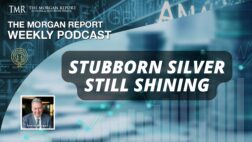Richard (Rick) Mills
Ahead of the Herd
As a general rule, the most successful man in life is the man who has the best information
Institutional investors tend to prefer investments that are thought to contain the potential for growth, growth = sprouts. An investment has to produce a growing revenue stream – if it doesn’t grow it doesn’t compound. Gold is rejected as an investment because it doesn’t produce sprouts, meaning the steady income and systematic growth so sought after by institutional investors just isn’t there.
Gold performs two jobs that fiat currencies, or any other financial innovation, cannot do; gold acts as a safe haven in times of turmoil – to escape Nazi Germany, or buy food and water in a crisis. Perhaps even more important, gold, for the last couple of thousand years has acted to preserve your purchasing power. In 1913 (the year the US Federal Reserve was born) the US dollar was well a dollar, gold was US$20 an ounce. Today, at almost the 100 year anniversary of the Fed the dollar has lost 95 percent of its purchasing power and gold is $1600 an ounce.
That’s gold, sprout-less yes, but irreplaceable in its functions.
Because of the upcoming massive debt rollover, and a collapse of faith in traditional collateral values, gold is quickly becoming a core banking asset.
Lenders loan money based on the criteria of:
o The borrower’s ability to service the debt – cash flow
o The borrower’s collateral
o A combination of both cash flow and collateral
Debt has a maturity, and when maturity is reached borrowers look to roll it over. Unfortunately for borrowers the value, and high levels of esteem, of what has traditionally been thought of as good collateral (sovereign obligations – currencies) has collapsed.
“Given the regulatory pressure to collateralize exposures, regardless of transaction type, there is a greater need for collateral. But going forward, there may be a risk of a shortage of good-quality collateral.” Olivier de Schaetzen, director, Euroclear
The following list, compiled by Bloomberg, shows the amount of debt that various nations must roll over in 2012:
Japan – 3 trillion, U.S. – 2.783 trillion, Italy – 428 billion, France – 367 billion
Germany – 285 billion, Canada – 221 billion, Brazil – 169 billion,
U.K. – 165 billion, China – 121 billion, India – 57 billion, Russia – 13 billion
According to Bloomberg borrowing costs for G-7 nations in 2012 will rise as much as 39 percent from 2011.
“The great corollary of over indebtedness is the relative scarcity of good collateral to support the debt load outstanding. This imbalance of debt to collateral is impacting the ability of banks to make loans to their customers, for central banks to make loans to commercial banks, and for shadow banks to be funded by the overnight Repo market. Hence the growth of gold as a collateral asset to debt heavy markets is inevitably in the cards and is de facto occurring. Gold is stepping up to the plate as “good” collateral in a world of bad collateral.” Professor Lew Spellman, former economist at the Federal Reserve and former assistant to the chairman of the President’s Council of Advisors
In February 2011, J.P. Morgan Chase & Co. said gold is at least as good an investment as triple-A rated Treasuries. J.P. Morgan started allowing clients to use gold as collateral in some transactions where traditionally only Treasury bonds and stocks have been accepted.
On May 25, 2011, the European Parliament’s Committee on Economic and Monetary Affairs (ECON) agreed to accept gold as collateral.
John Exter’s Inverted Pyramid
John Exter is known for creating Exter’s Pyramid – useful for visualizing the organization of asset classes in terms of risk and size.
When the credit system is expanding most money flows to the top of the pyramid – the increasingly speculative and illiquid investments. When the credit system comes under pressure and debt cannot be repaid, the items at the top of the pyramid get sold and money flows to the bottom items.
“Tier 1 capital is the core measure of a bank’s financial strength from a regulator’s point of view. It is composed of core capital which consists primarily of common stock and disclosed reserves (or retained earnings) but may also include non-redeemable non-cumulative preferred stock. Banks have also used innovative instruments over the years to generate Tier 1 capital; these are subject to stringent conditions and are limited to a maximum of 15% of total Tier 1 capital.” Wikipedia
The Basel Committee for Bank Supervision (BCBS), the maker of global capital requirements and whose Basel III rules form the basis for global bank regulation, is studying making gold a bank capital Tier 1 asset.
“Gold has historically been classified as a Tier 3 asset. When determining how much money a bank can loan, the bank’s gold holdings have traditionally been discounted 50 percent of the current market value. With value cut in half, banks have little incentive to hold gold as an asset.” Frank Holmes, usfunds.com
The BCBS is a committee of banking supervisory authorities established by the central bank governors of the Group of Ten countries in 1974. The Committee’s members currently come from Argentina, Australia, Belgium, Brazil, Canada, China, France, Germany, Hong Kong SAR, India, Indonesia, Italy, Japan, Korea, Luxembourg, Mexico, the Netherlands, Russia, Saudi Arabia, Singapore, South Africa, Spain, Sweden, Switzerland, Turkey, the United Kingdom and the United States.
If gold is made a Tier 1 Capital asset banks could operate with far less equity capital than is normally required. Gold would be the new backstop for debt, currencies and bank equity capital.
“Anyone who understands gold’s historic role will grasp the importance of the argument behind extra bank leverage. Direct ownership of bullion by a bank is superior to holding the fiat money issued by a central bank. It should increase confidence in any bank and the system as a whole. Given relative values, bank purchases of bullion will drive the value of gold as Tier 1 capital up relative to other qualifying assets, increasing its desirability for regulatory purposes further without a gold-owning bank doing anything.” Alasdair Macleod, resourceinvestor.com
Conclusion
If the Basel Committee agrees to banks using gold as Tier 1 Capital it would create substantial demand for physical bullion and be an important step toward gold’s re-monetization.
Consider:
Gold, if moved from a Tier 3 to Tier 1 asset would be competing as a safe haven investment against un-backed bonds yielding less than zero in inflation adjusted terms and issued by over indebted governments.
Gold is set to become the new “good collateral.”
Gold is unique, it is the only non-Tier 1 asset to be universally regarded by investors the world over as a flight to safety asset.
These considerations should be on all our radar screens. Are they on yours?
If not, maybe they should be.
Richard (Rick) Mills
rick@aheadoftheherd.com
www.aheadoftheherd.com
If you’re interested in learning more about the junior resource and bio-med sectors please come and visit us at www.aheadoftheherd.com
Site membership is free. No credit card or personal information is asked for.
***
Richards articles have been published on more than 400 websites including:
Wall Street Journal, SafeHaven, Market Oracle, USAToday, National Post, Stockhouse, Lewrockwell, Pinnacledigest, Uranium Miner, Beforeitsnews, SeekingAlpha, MontrealGazette, Casey Research, 24hgold, Vancouver Sun, CBSnews, SilverBearCafe, Infomine, Huffington Post, Mineweb, 321Gold, Kitco, Gold-Eagle, The Gold/Energy Reports, Calgary Herald, Resource Investor, Mining.com, Forbes, FNArena, Uraniumseek, Financial Sense, Goldseek, Dallasnews, Vantagewire, Resourceclips and the Association of Mining Analysts.
***
Legal Notice / Disclaimer
This document is not and should not be construed as an offer to sell or the solicitation of an offer to purchase or subscribe for any investment.
Richard Mills has based this document on information obtained from sources he believes to be reliable but which has not been independently verified;
Richard Mills makes no guarantee, representation or warranty and accepts no responsibility or liability as to its accuracy or completeness. Expressions of opinion are those of Richard Mills only and are subject to change without notice. Richard Mills assumes no warranty, liability or guarantee for the current relevance, correctness or completeness of any information provided within this Report and will not be held liable for the consequence of reliance upon any opinion or statement contained herein or any omission.
Furthermore, I, Richard Mills, assume no liability for any direct or indirect loss or damage or, in particular, for lost profit, which you may incur as a result of the use and existence of the information provided within this Report.



